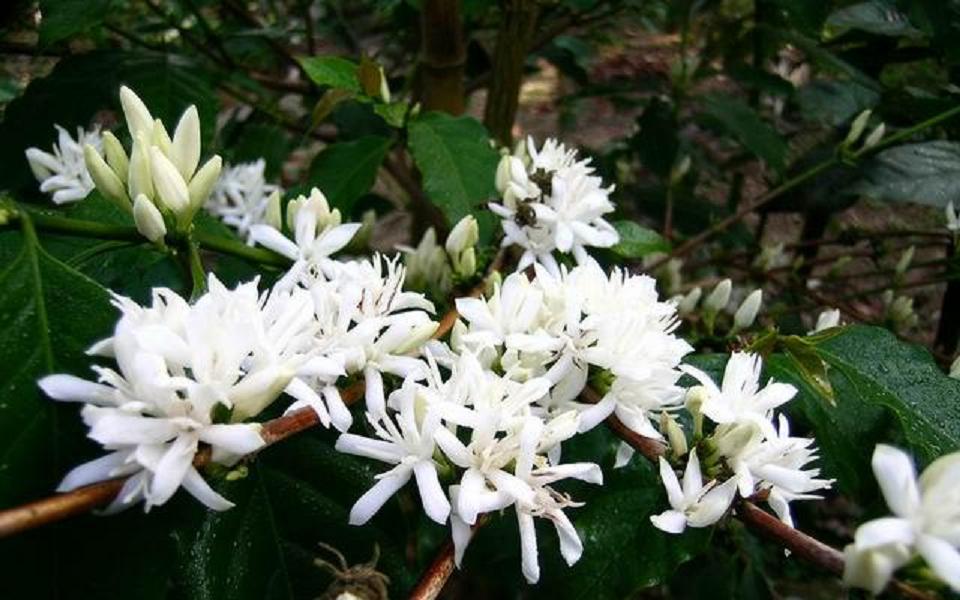Basic knowledge of coffee introduction: coffee flower coffee blossoms
Coffee flowers can be enjoyed at the beginning of the second or third year of coffee planting. if there are no special circumstances, they will blossom and bear fruit naturally, so it is easy to think that the harvest of coffee trees will be 2-3 years later.
Coffee flowers are white, born in leaf axils, where leaves come into contact with branches, usually appear in clusters, each flower will have 5-6 petals, slender micro-roll, see the picture is very clear, and jasmine is very similar, not only the appearance is similar, even the aroma are similar, so the 17th century will have Arabian-jasmine (literal translation "Arabian jasmine") name.
Generally speaking, Rain Water ushered in the flowering period after the same coffee tree, the same branch, or even the same flower cluster. Therefore, it is very common to see coffee flowers, coffee, green fruit, coffee and red fruit coexisting at the same time. Although it can meet the desire to see different things at the same time, but the harvest for coffee farmers may not be lucky, in order to ensure a high-quality harvest. Only manual picking can pick fully ripe coffee fruit, and manual picking is bound to face high costs.
A coffee tree may bloom sooner or later, but in general, there will be a relatively concentrated florescence, and depending on the climate and other factors of each planting place, there may be two or three periods, followed by two or three harvest seasons. Although the florescence comes with Rain Water, it is not so wonderful to meet Rain Water in the right blooming season. Rain Water's entry into the flowers will affect the results.
Although the coffee flowers are beautiful and elegant, the good flowers are not often there. They fade after 2-3 days and are replaced by small green coffee fruits.
Many articles have mentioned what a wonderful experience it is to visit coffee farms during flowering period, and many producing areas are happy to use coffee blooming season for tourism. According to news reports, Hainan has built a coffee museum to show the coffee processing process, but one of the major contents is the instant coffee production line. As for whether manors, trees and flowers are also on display, the news did not mention, but Yunnan coffee farms. Imagine that the coffee on the dam of Lujiang River is covered with coffee in blooming season.

Important Notice :
前街咖啡 FrontStreet Coffee has moved to new addredd:
FrontStreet Coffee Address: 315,Donghua East Road,GuangZhou
Tel:020 38364473
- Prev

Introduction to the course of making Italian Coffee-- understanding several misunderstandings of making Coffee
Milk is the best companion of coffee, we usually like to add milk when drinking coffee, especially fancy coffee, with beaten milk foam to pull out all kinds of flowers, so that the coffee with milk is both delicious and good-looking. For playing milk foam, there are several common misunderstandings that we need to understand, so that we can make it easier for us to do a better job of playing milk foam. 1: use shaking up and down
- Next

Chlorogenic acid is the slimming "hero" behind green coffee
Traditional caffeine is popular because of its rich flavor and refreshing effect, and has become a daily drink for many people. US researchers have developed a new green coffee blend that allows people to lose weight without changing their eating habits. This new green coffee, also known as slim coffee, is made from a blend of unroasted coffee beans and Arabica coffee beans. for
Related
- Beginners will see the "Coffee pull flower" guide!
- What is the difference between ice blog purified milk and ordinary milk coffee?
- Why is the Philippines the largest producer of crops in Liberia?
- For coffee extraction, should the fine powder be retained?
- How does extracted espresso fill pressed powder? How much strength does it take to press the powder?
- How to make jasmine cold extract coffee? Is the jasmine + latte good?
- Will this little toy really make the coffee taste better? How does Lily Drip affect coffee extraction?
- Will the action of slapping the filter cup also affect coffee extraction?
- What's the difference between powder-to-water ratio and powder-to-liquid ratio?
- What is the Ethiopian local species? What does it have to do with Heirloom native species?

